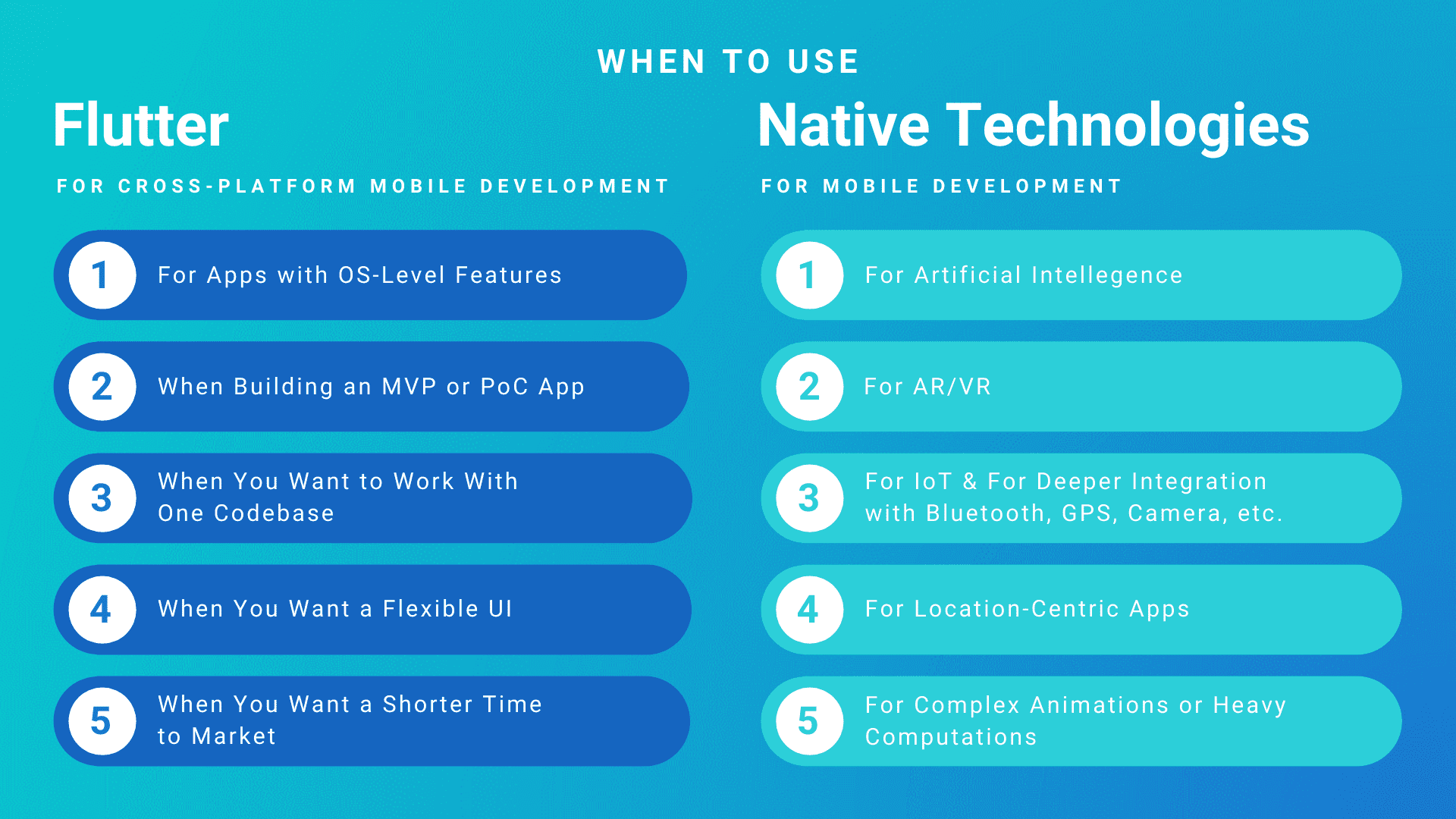Flutter vs. Native: an Examination of Cross-Platform Mobile Development
In the recent years, Flutter has become a bit of a buzz word in the cross platform mobile application development world, and there is good reason for it. It’s useful, and it can reduce development time and costs.
First released in 2018, Flutter is an open source framework developed by Google that allows developers to build beautiful, and natively compiled, cross-platform applications from a single codebase. It’s not surprising that it’s popularity continues to increase. Stack Overflow surveys show that the use of Flutter has nearly doubled in the last year, increasing from 7.2%, of those surveyed in 2020, to 13.55% in 2021.
Cross platform mobile application development tools are an alternative to using native mobile app development technologies. Using a native technology means that you are building a mobile app for a single platform with the technology and tools that are native to it. Native tech for Android includes Kotlin, Java, and Android Studio, and native tech for iOS includes Swift, Objective-C, and Xcode.
So, which is better? Does Flutter replace the traditional native development toolset?
Well, let’s see. Both Flutter and native tools are useful and highly scalable, but there are some big differences in development, costs, performance, and maintenance, and more.
In this article, we cover when one should opt for Flutter for cross platform app development and when one should opt for the native stack. To help with this, we spoke with IBA Group’s mobile developer Victor Mironchik, an iOS expert with more than ten years of experience. He recently worked on a Flutter project to create a money transfer app for parents and their kids for one of our clients in the Fintech domain.
More explicitly, we explore:
- Cross-Platform Mobile Development with Flutter
- Maintenance and Support for Cross-Platform Mobile Development with Flutter
- Integration and Access to Platform Specific Features
- Flutter vs. Native App Performance
- When Native Tools Are Best
- When Flutter’s the Way to Go
Then, we’ll take a look at a side-by-side comparison of the strengths of Flutter and Native tools to help you make the decision of what is best for you.

CROSS PLATFORM MOBILE DEVELOPMENT WITH FLUTTER
Cross platform mobile development with Flutter enables you to write the code once and run it on either platform, Android or iOS. This reduces development time and cost.
Some things we love about Flutter:
- Flutter employs the programming language Dart, a modern language that’s simple to learn.
- It comes with good documentation.
- There is a great developer community around Flutter.
- The Common Line Interface (CLI) is easy to use, which helps when setting up the development environment.
- There’s no dedicated IDE for Flutter/Dart. Any code editor, like VS Code, can be used.
Due to its ease of use, Flutter can reduce training times since it takes less time to learn Flutter than native stacks. On top of that, if you’re building an app exclusively with Flutter you’ll require less developers than if building separate apps for each platform. Because of this, Flutter development has been found to be faster compared to the development of apps natively.
That said, as Victor pointed out, “The extent to which this is true depends on the development team you have and the goals of your project.” If you’re working with a team of native mobile developers who have never used Flutter before there will, of course, be a bit of a learning curve. Thankfully, Flutter is not difficult to learn. And “once a Flutter team matures,” Victor adds, “development speed increases as we only need to create and maintain one codebase.”
When developing with Flutter, it is still necessary to keep Android and iOS in mind, since there isn’t much of a point in building a mobile app for some abstract platform. Both these platforms come with their own set of possibilities and limitations that should be accounted for. This is why IBA Group prefers Flutter developers to have additional experience in native development.
MAINTENANCE AND SUPPORT FOR CROSS PLATFORM MOBILE DEVELOPMENT WITH FLUTTER
As mentioned, one of the biggest selling points of working with Flutter is that you only have to manage one codebase. Just as this saves you time and money during development, this can do the same when it comes to maintenance.
Thankfully, with Flutter, maintenance is easy. To bring changes to both Android and iOS, all a developer needs to do is modify just one piece of code. This wouldn’t be the case when developing natively for both platforms. When using native technologies, two separate code bases need to be maintained, and you would have to check for bugs and deal with updates for each, often resulting in the need for a larger team.
The “Hot Reload” feature, in particular, is incredibly useful for development and app maintenance with Flutter. Hot Reload allows you to instantly test code changes on a physical device. This helps with adding features, fixing bugs, building UI, and it encourages and facilitates experimentation.
INTEGRATION AND ACCESS TO PLATFORM SPECIFIC FEATURES
As mentioned, Flutter has quality documentation, a great community, and plugins to help with any hurdles that might arise when integrating it with iOS and Android. However, this is a place where, depending on what you’re building, native app development might be a better fit.
Both Swift and Kotlin offer seamless integration with almost any aspect of platform specific features. These include features like bluetooth, location, accelerometer, and camera. While it’s not difficult to do this in Flutter, it often requires the use of external libraries (plugins) for this purpose. In some cases, this can lead to the risk of external dependency. “This is especially true when plugin support is limited,” said Victor. “You should be ready to dive into the plugin source code if its author is not available and you can’t address your issues to them.”
Thankfully, there are a large number of plugins available for Flutter. If Google, or someone else, already developed a plugin that can deliver what you need, then you’re in luck. Otherwise, you might need to create your own plugin. “This was the case for our recent project for the money transfer app development,” Victor shared. “We needed a plugin that allowed us to share the kid’s location even in the background. For this, we had to create our own plugin. And to do this, you’d need — as we did — some native development experience to do this.”
FLUTTER VS. NATIVE APP PERFORMANCE
It’s not a surprise that native technology brings the best performance. Native software is tightly coupled with the hardware as a direct result of vendors’ efforts. No other technology will provide the same results.
Flutter apps are bigger in size, as it’s influenced by Flutter’s engine. However, as we have more and more storage in our devices these days, this is less of an issue. Tests and measurements have also found that Flutter apps are slower than native apps and consume more energy; however, it’s not really to a substantial degree. Often users can’t even tell the difference between a native and a Flutter app. Flutter apps still provide a first class user experience if designed properly.

WHEN NATIVE TOOLS ARE BEST
Flutter is a wonderful tool, but there are some scenarios, where we would recommend using the native stack. In particular, the native stack is ideal for purposes such as:
- Augmented reality/Virtual reality
- Artificial intelligence
- Complex animations
- Location-centric apps
- Internet of things apps that connect to other devices by, for example, Bluetooth
WHEN IT’S PERFECT TO USE FLUTTER
Flutter can be perfect for cross platform app development in both B2C and B2B sectors for both publicly available and proprietary enterprise application development. This is particularly relevant for startups building MVPs and PoCs.
Flutter’s ability to create the first class UI, its documentation, wide developers’ community, shorter development lifecycle, and reduced development costs are the key points that attract more and more customers and developers worldwide.
Flutter is used in a wide range of business domains including:
- Education
- Medicine
- Transportation
- Logistics
- Finance
- Mass media.
These include companies such as Google, Alibaba Group, BMW, eBay, and Square.
FLUTTER VS. NATIVE: SIDE-BY-SIDE

IBA GROUP’S WORLD CLASS CROSS-PLATFORM MOBILE DEVELOPMENT
Should you have a need to build a Flutter, or a native, app our team is ready to provide you with a mature full cycle Flutter development team with real Flutter projects experience.
Flutter is an incredible tool that offers a wide range of benefits for developers and businesses. Flutter brings you a beautiful looking UI and it’s a great choice in many circumstances, particularly when facing a faster timeline and decreased budget.
We can provide you with a comprehensive cross platform app development solution based on Flutter with our agile team-as-a-service approach. Our team is ready to help you develop a robust solution that works flawlessly across both iOS and Android. Still confused what technology would be the best for your product? Looking for an app to be built? Don’t hesitate to reach out to our experts who are prepared and ready to help with this, and any other of your mobile development needs.
YOU MAY ALSO BE INTERESTED IN
- Ten Advanced Checks You Need to Get a High-Quality and User-Friendly Mobile App
- QA or not QA? Why Quality Assurance is so Important for the Success of Your Mobile Application
- Creating Your Mobile Business App: Costs, Team, Outsourcing
- A Story of Success: Mobile App Development for a Major Client in Logistics
- What You Need To Develop a High Quality Transportation App
- Building a Terrific Team to Create a Mobile Application
- An App That Matters: Getting Great Results with A/B Testing
- Dealing with Map-related Challenges and User Onboarding Experience in the Vehicle Tracking App